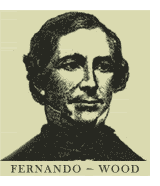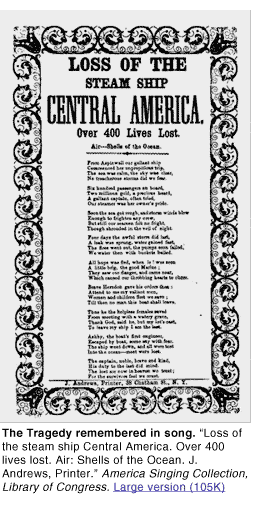
“The Central America Engulfed in the Ocean, About Eight the Ship Began to Settle Rapidly, When She Momentarily Righted and Went Down Stern Foremost.” Illustration in Frank Leslie's Illustrated Newspaper October 3, 1857. Courtesy Prints and Photographs Division, Library of Congress.
An Introduction to a Turbulent Period of New York City History
By Gregory Christiano
The year 1857 in New York City was a memorable one, or rather, a harrowing one. It was a terrible time for the City and the nation. A year best forgotten because of its painful consequences. Not only were the two police forces battling each other, gang warfare broke out in July. Police battled police, police battled gangs, gangs battled gangs, and gangs attacked pedestrians, shopkeepers and residents. It was an incredible scene of mayhem and unrest. To compound this already volatile situation, a great financial crisis that was ongoing all year resulted in a panic on Wall Street and a run on the banks. The Great Financial Panic of 1857 was part of this catastrophe, undermining public order.
Fernando Wood (1812 – 1881) had been elected Mayor of New York City in 1855 and was reelected in 1857. While in office the Municipal Police Force (established in 1853 by the New York State Legislature) became as
corrupt as could be. Mayor Wood was held responsible for this deterioration in the integrity of the force. Because of Wood’s involvement, Albany shortened his second term in office from two years to one and then created the Metropolitan Police Force (Frederick Talmadge as Superintendent). This force was intended to replace Wood’s corrupt Municipal Police. In May 1857 the Supreme Court ruled in favor of the Metropolitan Force and ordered Wood’s Municipal police to disband. Wood refused and was backed by Superintendent George W. Matsell, 15 captains, and over 800 patrolmen.
 |
||
The arrest of Mayor Wood was ordered. Captain Walling of the Metropolitan Police was sent to arrest the Mayor but was promptly thrown out on his ear. Wood occupied City Hall protected by 300 of his Municipals who resisted a force of 50 Metropolitans sent there to arrest him. Later that day 50 Metropolitan Police descended on City Hall with night sticks in hand to carry out the order. The Municipals ran into the street and the two factions fought each other. The Metropolitans retreated. 52 policemen were injured, one crippled for life. The Metropolitan Police Board then called in the National Guard who surrounded City Hall. The Mayor finally submitted to arrest but soon returned to office released on minimal bail.
 |
||
One such incident occurred on June 14, 1857. Members of the Metropolitan Police Force arrested a man for disorderly conduct, but he was seized by a member of the Municipal Force. Immediately the Metropolitans regained custody and arrested the city officer who attempted to interfere. Well, later that day, a group of Municipals stormed the Metropolitan Police Station on East 6th Street. It grew much more serious the next day. This was so typical. When an arrest was made and the alleged criminal brought to the station house, an alderman or magistrate from the opposite camp would be waiting and got this person released on the spot! It was not unusual for rival policemen to club each other to determine who would get the right to arrest a suspect.
Finally on July 2nd, the Court of Appeals upheld the decision of the Supreme Court and with the State Militia supporting the Legislature; Mayor Wood had no choice but to disband the Municipals. Some of the men were accepted into the ranks of the Metropolitans.
All this turmoil and infighting made it easy for the gangs to run wild through the streets. This led to the gang riots.
On the Fourth of July (just two days after the Municipal Police Force was disbanded ), the Dead Rabbits, Plug Uglies and other minor gangs from the Five Points banded together to do battle with their arch rivals, the Bowery Boys. They attacked the Bowery Boys’ headquarters using every weapon at their disposal – knives, pistols, clubs, iron bars. The battle raged along Bayard Street – it was a desperate free-for-all. The Metropolitans tried to intervene but were beaten off.
The bloodshed continued unabated spreading to Mulberry, Elizabeth and Baxter Streets. While this was going on and the police were distracted, other gangs found this to be a golden opportunity to loot and pillage the neighborhoods. Shopkeepers, pedestrians, and residents were all fair game. The pedestrians were most vulnerable. The storeowners and residents barricaded themselves in their buildings employing shotguns, pistols, brick-bats or any other weapon to protect themselves. It was total anarchy run rampant!
The police made another fruitless attempt to clear the streets, sometimes driving the thugs into buildings, up to rooftops, into back alleys. One criminal fell off a roof, or was pushed, and fell to his death. Some were trampled by the cops, but the police were forced to retreat with only a few prisoners. It was a pathetic scene. Subsequently, three regiments of militia were ordered to restore order, which they did and by July 5th regained control of the streets. Some isolated fighting continued for a week afterwards, but the rioting was essentially over.
There was a public outcry over thus utter chaos. Both the Metropolitan and the defunct Municipals filed suit against Mayor Wood for the city riot. A judgment was awarded and the Mayor had to pay $250, but never did pay it! The number of dead will never be known. Gang members buried many of their dead in secret.
THE FINANCIAL PANIC OF 1857
The United States was in a recession (a period of reduced economic activity) for most of the 1850’s and it grew worse when on August 24, 1857, the New York Branch of the Ohio Life Insurance and Trust Company failed.
The embezzlement of railroad bonds caused the insolvency, thus leaving enormous debts. New York bankers at once restricted routine transactions and individuals who held stock and commercial paper rushed to make deals with their brokers. Major stocks fell 10% in one day, and fortunes were lost overnight. Depositors demanded payment in gold from the banks that just happened to be waiting for a shipment of gold from the West Coast. It never arrived. There was a disaster at sea.
The steamship S. S. Central America carrying over $1 million dollars in commercial gold and a shipment of 15 tons of federal gold (valued at $20 an ounce) sank near South Carolina on her voyage from San Francisco. She went down in a hurricane on September 12, 1857. The gold intended for the eastern banks went down with the ship. This sent a shock wave through the financial community. [Since the demise in 1836 of the federal or Hamiltonian banking system, the federal government was not prepared to provide regulations to coordinate the operations of the banks. Banking transactions were conducted in silver and gold, not paper money]. The consequences of this disaster at sea were pervasive and swift. On October 3rd there was a marked increase in withdrawals. People suffered financial ruin.
By October 13, 1857 suspension of specie payments resulted in the rest of the banks to collapse creating financial panic. The banks had to close, not to open again until November. Unemployment rose, real estate prices fell, manufactured goods lay dormant in warehouses, the railroads defaulted on their debts, land speculation, dependent on railroad construction, failed also. Half of Wall Street’s brokerage houses went out of business. Russia undersold U. S. cotton on the open market; British investors removed funds from American banks; grain prices fell spreading economic hardship to rural America. No recovery was in sight.
The impact was devastating and long-term. This setback caused major slowdown in capital investment, commerce, and land development (construction in New York City all but ceased). The rate of immigration dropped and there was significant job loss nationwide. Strangely enough, the South was hurt less, undoubtedly because of their slave economy.
The recession led to panic (the worst moment in a financial crisis) which in turn led to a depression (a serious and prolonged period of low economic activity with sustained and rising unemployment). This depression lasted over the next three years until the outbreak of the Civil War.

